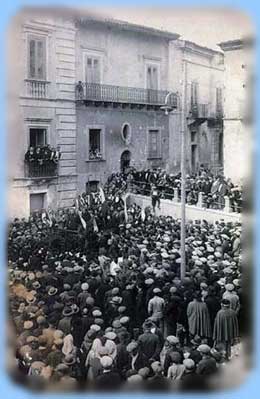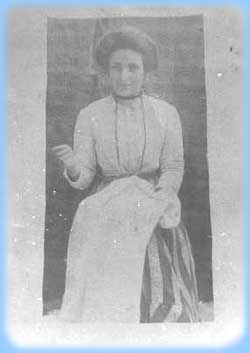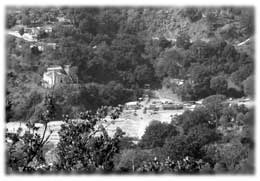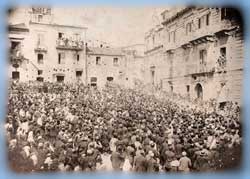 |
|
------- Part one - Corriere di Caulonia - December 1987..February 1988
|
|||
|
|
Many young Caulonians, young Don Abbondios, asked themselves: Who were Cola and Tocca? Let us say that Nicola Ciccarello known as Tocca, belongs to an age old story which we have chosen to unearth because it is closely related to the history of Castelvetere in the italian Risorgimento period. We often hear talk of the five martyrs of Gerace who were related to our area but most people probably know no more than that. |
||
|
We are in 1847 when Caulonia is still known as Castelvetere and three of the five martyrs of Gerace, along with another two revolutionaries, led by Nicola Ciccarello, find refuge in the local cave under the town of Strano. “The scoundrel hid them but then reported them and had them arrested”. With these words the arch-priest Davide Prota interprets the event in his 1913 publication “Historical researches on Caulonia”. For all the respect we have for the arch-priest Prota, we do not agree with his description of Tocca, which undoubtedly come as a consequence of the feelings which arose from a recent event to which time would be able to give a better view. During Prota’s time, however, Ciccarello appeared to be a “scoundrel”. Although we are these people’s descendants, we do not hazard any judgement, we limit ourselves to refer the circumstances, the mentality, the environmental factors and the historical period during which the event took place, thus leaving the judgement to each individual reader. For over a century Europe had been in turmoil For over a century Europe had been in turmoil. The populations had fulfilled the Renaissance period and were asking for guarantees in the shadow of the Constitution. The most spirited and brave people
were meeting secretly. It is the case to underline the fact that a century earlier, in 1750, the Neapolitan statutes defined the freemasons as “a group of citizens made up of morally worthy men in religious terms and in terms of the State who were united in order to bring well-being to humanity with the closest bond of virtuous friendship within a sole, well ordered family”. It is therefor possible to confirm as correct those historians who date the birth of the freemasons in our area from 1743, exactly ten years after the foundation of the first Italian freemasons loggia in Florence in 1733. Returning to our story, at the period in question, the confusion among the carbonare factions was great so that even Mazzini, who became a freemason, in 1829, intending to permeate the loggia with a more modern spirit, two years later founded the “Giovane Italia” (young Italy) bringing more disharmony to the factions. In the Neapolitan area, the murattiani disappeared. They were trained by the filadelfi and they had created a considerable current of French thought while the carbonari growing from the pre-existent freemasons of the Scottish rite, signed up its followers from the army and among the bourgeoisie, finding their expression in their patriotic and constitutional aspirations. The various carbonare currents of thought, however, which seemed more like a political actionist party were missing an efficient and unique program which harmonised them all resulting in them knocking on the freemason’s door seeking a central government. The result was the institution of a number of loggie in the main centres of the Bourbonist kingdom, among which was the loggia of Castelvetere, whose influence stretched from Bianco to S. Caterina. Those people no longer physically able to carry out disturbance actions, participated in Masonic meetings, while the youths, who were more active, remained carbonari and only a few of them, those with the third degree, that of teacher, had access to the loggia. The aftermath of the execution of Gioacchino Murat Following the disappearance of the current of French thought, after the execution of Murat who obviously had learnt nothing from the Swabian Corradino, the repubblican current of thought took over, as a consequence of Mazzini’s infiltrators. This current of thought was the one which programmed a national unity under Ferdinando II’s leadership to whom, at the age of ten in 1820 and then King from 8/11/1830, they thought of giving first the crown of Lombardia and later that of King of Italy, which he officially gave up. The same current saw Pio IX as the solution to the national problems and it was also the one which dominated in the ramifications of obbedience to the Loggia di Castelvetere. Lastly, it must not be forgotten
that in 1847, the region of Piemonte gave asylum to the patriots of
Lombardo-Veneto. Carlo Alberto did not hide his aspirations and probably,
had he not overly attempted, would have reached very different positions
to those which sent him to Oporto. This explains the presence, in the Regno delle due Sicilie of a carbonara current of Piemintese thought. It is easy to imagine the agitation with which the sittings in the loggia d’oriente of castelvetere took place, more so because the carboneria was growing with the joining of working class members and farmers subjecting the religious beliefs via the divulging of the cult of S. Teobaldo (symbol of the struggle of man against oppression) and the devotion to its protector S.Giovanni Evangelista. Prota writes more: as well as the problem of banditry, there is also that of the carbonari. These sectarians called their auditions “sales”, sheep representing them, wolves representing the French, and the general population represented as lambs; the sales were carried out in the presence of a blood encrusted corpse known as the sole son of God killed by the wolves. This sect, as well as the destruction of the French they aspired to a Republic. Various of the most conspicuous citizens of Castelvetere belonged to this sect because it was fashionable, in those times to be a carbonari if one was from a more wealthy family and had a good education in Castelvetere. Evidently, Prota confused Freemasonry with carboneria, the only republicans belonging to the latter category were those from the Giovane Italia organisation. As to the sales in the presence of a blood covered corpse, one must make allowances for Prota remembering that he, as an arch-priest, belonged to that church which does not accept other doctrines that are not its own. Venerable teacher of our loggia was Angelo Raffaele Campisi (who was to become a member of the first Italian parliament based in Florence:1865-1870). There was no temple, as the Masonic statute would have wanted, the meetings took place in the building which today belongs to Dr. Angelo Riccio. The building has many rooms with more than one exit, among which, in the rear, one with an exit onto a secondary lane with access to the stables. In other words, the building is a great help to those who need to hide. To this one must add the omertà (silence) which comes as a consequence to the feelings of revering and devotion which bend the Caulonians to loyal deference towards those who possess a moral or social superiority. Nicola Ciccarello, from Strano, belonged to a farmer’s family. His father, Giuseppe, was “literate” because he had attended the second class and his children did not want to do any less, being as they were, proud of their father. Nicola was the eldest, he was the trusted man of the Campisi family which held no secrets for him. He was the Ciccarello who, when Masonic meetings were held, would introduce the guests, inviting them into the house and offering them rosolio or wine but also listening to their preamble. Messina rises up on the 1st of September Let us get into the thick of the story: on the 1st of September 1847 the city of Messina uprises and within a few hours it was under the control of the carbonari. The Bourbonist troops barricaded themselves in their barracks ready to defend themselves from any eventual attacks, which did not come about. On the 2nd of september, Domenico Romeo from S.Stefano and Rocco Verduci from Sant’Agata di Bianco, called together the carbonari of the area and were joined by those of Salvadori of Bianco and those of Gaetano Ruffo from Bovalino. The Ionian strip was in turmoil but Castelvetere wasn’t taking any action. The local carbonari watched the Campisi building waiting for orders and by the evening of the 3rd of September, while the square (Piazza Seggio) and the smaller square of Mortella were teeming with expectant youths, the tension within the building was mounting.
|
|||

|
Roccella made its move with
few elements led by Pietro Mazzoni, Stefano Gemelli and Giovanni Rossetti
who sent diplomatic legations to Castelvetere which were to await dispositions
and, above all, the numerous forces of armed men. Within the building,
however, the freemasons in meeting did not agree on any decision and
at around two in the morning on the 4th of September they
sent out an invitation to be calm while waiting for the events to unfold. |
||
|
Reality betrayed such expectations because he handed over those responsible for the revolt limiting himself, and not always successfully, to saving their lives. On the 7th of September, every sign of revolt had been crushed but the climate was still hot and tense because, from north, came the news that Carlo Alberto was mobilising his army. Therefor it was decided that it would be wise to hide the leaders of the revolutionaries and wait for events to evolve. The Campisi brothers, Raffaele and Nicola, took on the task of hiding them and sent the people from Roccella back home telling them to warn the revolutionary leaders to meet in a place where they (the Campisi brothers) would be able to lead them into the building. On the road to the Catalano di Roccella Wood, shortly after the turning for the Salice, on the right, there is a small chapel dedicated to S.Sostene, around it are the remains of a small friar’s convent. Before dawn on the morning of the 8th of September, Salvadori, Verduci, Bello and Gemelli were hiding among the ruins when Nicola Ciccarello arrived, sent by the Campisi family. The weather was worsening and Ciccarello suggested they move to a closer hiding place in a nearby cave, under the town of Strano, which was in an area which he knew well. In the first light of dawn the five men eat the food sent by the Campisi which Ciccarello had brought and chose a corner in which to rest. More than the food, the wine raised the mens’ spirits, and Ciccarello’s voice joined in with the others. Ciccarello was a clever and observant man, ready to grasp a useful opportunity from any situation without ever sticking his neck out, and he did not agree with the stance taken by the four youths to whom life seemed to have given more than necessary. Start a revolution? Why?…Against our king who is a gentleman. The three efs: Festa, farina and forca (festivity, flour and pitchfork) He agreed on the unity of Italy, but under a republic not under the Savoia family or Pio IX. The Savoia would have sent the Carabinieri (a police force) and tax agents and Pio IX would have sent the dominion of the priests. Had the Bandiera brothers not been there to disrupt things three years before, the king would already have conceded the constitution, he thought. The three efs: Festivity, flour, and pitchfork? He thought: let’s enjoy the festivity and the flour, and let those who go in search of it, meet the pitchfork. The festivity of Crochi At dawn on the 9th September the air is like that of the calm following a storm, it is Sunday. The sky is blue and at the Contrada Crochi, the traditional festivity of the Madonna is held. The participants are multitudinous and come from the many nearby villages. Besides the religious aspect, the festivity of the Amusa riverside, is also an annual meeting place for families and friends who live at great distances. It is an occasion for the many priests from the centre, from Campoli di Ursini and from San Nicola to meet and agree upon the asking price for a mass or a funeral: the saying says, there’s strength in numbers. The festivity also heralds unions in marriage. Rosa from San Nicola says to her husband: “Bruno, do you remember when our Mariannina was born, when the compare Nuciforo di Candidati came to see us? When they drank our wine from the Calatria vineyard? Do you remember when compare Ilario remarked that a vineyard capable of producing such wine certainly sold its soul to the Devil? Do you remember that they brought their son Ciccillo who was six years old? |
|||
 |
”Mastro Bruno, Rosa’s husband,
while struggling with a cannata of wine which finishes too quickly,
merely nods. Long experience teaches men the wise habit of never speaking
to their wives, they merely nod yes or no. |
||
| On the eve of the Crochi festivity, this kind of discussion happens in Campoli as in Focà, in Pezzolo and in Popelli, in Obile and in Finocchio: wherever there is a young man for whom a wife must be found even more so where there is an old girl, sixteen years old, who needs a husband. |
|||
 |
From the early afternoon on Saturday, as well as the feràri with their crates of curd, cheeses, bechamel and buns, there are professional, and non, butchers.The victim is the goat and the typical, traditional meal for the Saturday evening is the cotto, with giblets and other insides quickly washed out in the river and cooked in chunks with tomato and chilli along with spicy dried meats. It is an ancient tradition to enjoy these dishes. | ||
|
The careless young boys, without a thought and full of wine, seem to smell the scent of the young virgins lying under the olive trees, where they languidly watch the young men who frenetically dance to the harmonica tunes singing: “duvi t’ha muzzicatu lu tarantulu mbielenatu? Si t’ha muzzicatu alla panza, panza cu panza nun c’è crianza…” The old people carry on eating the cotto which becomes ever more tasty because it is less and less clean. The women mutter their prayers and rest in the church. The Virgin, from her pedistal, smiles down on everyone, even those who swear because they are drunk. The arrival of Ciccarello For Tocca, the Crochi festivity was a strong temptation and he had never missed one since he was ten years old. He left the revolutionaries in the cave telling them that he wanted to go to Castelvetere to meet the Campisi brothers. In truth he left the cave, descended to the riverbed and came back up when he reached Crochi. Once in Crochi it is easy to imagine how he spent his hours. The embraces and the greetings seemed to never end, as did the glasses of wine until he encountered his old friend Domenico Cerchiara under a marquee and eat two plates of goats meat stew. Domenico Cerchiara was a fanatic Bourbonist and very sharp, so much so, that although being semi-literate and living in Campoli, he was nominated urban deputy chief. He knew about the Campisi’s anti-Bourbonist feelings and he knew them to be well informed about the happenings of the last few days and probably also about the fugitives’ hiding place. He also knew of the trust that the Campisi had for Ciccarello, although he was their servant, and that Ciccarello did not share their conspiring ideas. All the members of the Ciccarello family were notoriously famous for their loyalty to the monarchy and it will become apparent how, thirteen years after this episode, they would pay for this loyalty with their lives which a historical irony marked with betrayal. The sharp Domenico Cerchara knew everything and was capable of pretending to be an idiot when he had to understand other people’s good faith. Ciccarello’s and Cerchiara’s patriotic ideas found common ground and both men were intelligently astute with the distinguishing difference that Ciccarello was uninterested and therefor not malicious, while Cerchiara was an able man of all trades. The two were pleased to meet over some food and wine. One glass followed the other as did the things confidentially said… The arrest When the statue of the Madonna was taken back to the church at midday, after the fireworks, indicating the end of the festivity, the two friends parted company. Nicola Ciccarello along with other people, began to walk up towards Castelvetere to reach the Campisi building. The urban deputy chief Cerchiara went to find the other three civil guards positioned around Crochi to quell any eventual revolt which systematically occurred each year thanks to the much food and drink. He walked along retracing the path Ciccarello had walked that morning and at two p.m. he arrested the four unfortunate revolutionaries who in turn did not put up a fight. They entered Castelvetere in chains via the Amusa bridge which was milling with people, they walked up to the convent behind the church del Rosario where they were incarcerated. The convent, once belonging to Dominican monks, was severely damaged by the earthquake of the evening of the 5th of February 1783 the repercussions of which carried on until the 30th of June. The earthquake caused the collapse of part of the town walls thereby reducing the convent, which was built directly onto part of them, to rubble leaving intact only a few rooms on the ground floor. During the second French occupation of 1806, the convent was the rebel’s refuge which was not adequate to withstand the invaders, so, in 1811, Gioacchino Murat announced its closure and converted the remaining monks’ cells into prison cells. |
|||
 |
When the four unfortunate rebels
walked through the streets of the town everyone began to shout: they’ve
arrested the carbonari! Inside the building, Nicola Ciccarello was standing before don Raffaele having just finished reassuring him that within midnight the four friends would be safely installed in the stables. He was just concluding with: “Leave the door open and then I will warn you from the back door”. |
||
|
Having reached the square, stopped by the people who wanted to know for sure of the arrest of the four, he took the road downhill to the porta Amusa where he knew was the worse drinking cove of the town and ended the evening with by getting utterly paralytic. The town, meanwhile, was in ferment. Many were shouting that the prisoners would be freed during the night but, by this time, the position of the local freemasons and of the carbonari was precarious. In Gerace Marina (Locri) at around midday, Captain Alessandro Nunziante had already arrived and did his job as a Bourbonist official, which was the opposite of all the expectations and hopes of the local carbonari. The urban deputy chief Cerchiara, showing a prudent cunning worthy of every praise, did not mention the Campisi brothers or Ciccarello in his report, partly because he wanted all the credit and partly out of gratitude to Ciccarello who, although involuntarily, set him on the rebels’ track. Cerchiara was awarded the cross of Knight to the order of Francesco I and 2000 Ducati (around 10 million lire in today’s value) were divided among all those who partook in the arrest of the rebels. Following the Unification of Italy, Cerchiara, who was then strapped for cash, sold the cross to an idiot from Campoli for 60 piastre which were around one million and two hundred thousand lire in today’s value. |
|||
|
|
|
||
 Copyright© 2000 Caulonia 2000 per continuare a cambiare - All rights reserved |
|||


